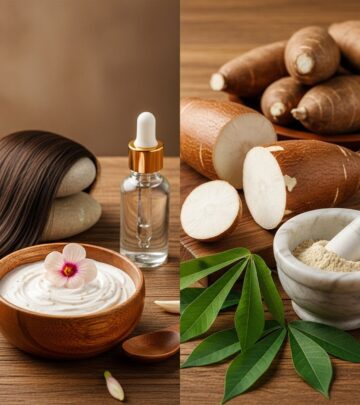Glyceryl Myristate: Cosmetic Ingredient Profile, Safety, and Use
Discover the science, uses, safety information, and regulatory status behind Glyceryl Myristate in personal care and cosmetic products.

Glyceryl Myristate: Comprehensive Ingredient Overview
Glyceryl Myristate is an important cosmetic and personal care ingredient widely valued for its multifunctional properties as an emollient and emulsifier. Its versatility has made it a staple in a range of formulations—from creams and lotions to cleansers and sunscreens. This article provides a detailed look at Glyceryl Myristate, including its chemical background, functions, safety profile, common uses, and regulatory status within the cosmetic industry.
What Is Glyceryl Myristate?
Glyceryl Myristate is an ester formed from glycerol (a natural alcohol) and myristic acid (a 14-carbon saturated fatty acid). The combination results in a mild, multifunctional compound used predominantly in skin care and personal hygiene products.
Myristic acid itself is naturally occurring and can be derived from plant oils (such as coconut or palm kernel oil), as well as animal fats. Glyceryl Myristate is typically obtained through plant sources or synthesized for cosmetic use to ensure safety and purity standards.
| Chemical Name | Glyceryl Myristate |
|---|---|
| INCI Name | Glyceryl Myristate |
| Chemical Formula | C17H34O4 |
| Major Components | Glycerol, Myristic Acid |
| Physical Form | Waxy solid, white to slightly off-white |
| Solubility | Lipophilic (oil-soluble) |
| Source | Plant or synthetic origin |
Chemistry and Manufacturing of Glyceryl Myristate
Glyceryl Myristate is synthesized through the esterification of glycerol and myristic acid. The reaction yields a monoester that is stable, non-irritant, and versatile in its applications.
- Myristic Acid: A saturated fatty acid with 14 carbon atoms, present in coconut oil, palm oil, and dairy fat.
- Glycerol: Also known as glycerin, a naturally occurring alcohol obtained from plant oils.
- The *esterification* process combines these two, resulting in Glyceryl Myristate—a mild, lipophilic compound suitable for skin contact.
The ingredient can be made from either wholly plant-derived materials or by synthetic routes complying with cosmetic safety standards. Its physical properties, including its waxy texture and melting point close to skin temperature, are ideal for creating pleasant-feeling cosmetic products.
Functions and Benefits in Cosmetics
Glyceryl Myristate serves several functions in cosmetic formulations, making it highly valuable for product texture, stability, and skin feel:
- Emollient: Softens and smooths the skin by forming a light, protective film. This helps to lock in moisture and reduce dryness.
- Emulsifier: Helps form and stabilize emulsions (mixtures of oil and water), giving a consistent texture in creams and lotions.
- Opacifier: Increases opacity, imparting a white, creamy appearance to cosmetic products.
- Texture Enhancer: Improves the sensory properties so creams and lotions feel silky, rich, and non-greasy after application.
- Moisturizer: By preventing water loss through the epidermis, it maintains skin hydration and prevents flakiness.
Key Benefits at a Glance
- Provides a pleasant, soft, and powdery skin feel
- Enhances spreadability and application of skincare products
- Stabilizes formulations and prevents product separation
- Non-comedogenic (does not clog pores)
- Suitable for sensitive and all skin types
Applications of Glyceryl Myristate
This ingredient is highly versatile and found in a wide array of cosmetic and personal care products:
- Moisturizers (face and body creams, lotions)
- Cleansers and facial washes
- Sunscreens
- Makeup products (foundations, primers, BB/CC creams)
- Hair conditioners
- Baby care products
- Deodorants
In each of these applications, Glyceryl Myristate offers sensory enhancement, stability, gentle hydration, and improved product feel.
Safety Information and Toxicology
Glyceryl Myristate is regarded as safe for use in cosmetic and personal care formulations when used at recommended concentrations. The safety record is based on extensive review by expert scientific panels and regulatory authorities.
Key Safety Findings
- Low irritation potential: Studies generally report minimal to mild skin irritation; it is considered non-sensitizing and non-allergenic for the majority of the population.
- Ocular safety: Minimal irritation has been observed in eye studies.
- No evidence of carcinogenicity, mutagenicity, or reproductive toxicity when used in normal concentrations in formulations.
- Well-tolerated on sensitive skin: Approved for use in formulations for sensitive groups, including baby and child-care products.
Irritation and Sensitization
Glyceryl Myristate is generally not associated with allergic or sensitizing reactions. Patch testing and repeated exposure studies have shown it to be safe for use across age groups and skin types, except in rare cases of individual hypersensitivity.
Recommended Use Levels
- Recommended concentrations in facial and body products typically range from 0.5% to 5%.
- It can be safely combined with a broad range of cosmetic ingredients.
How Glyceryl Myristate Works in Formulations
Its unique properties make Glyceryl Myristate crucial for enhancing both the texture and effectiveness of products. Here’s how it operates in different types of formulas:
- As an emulsifier: Supports stable blending of oils and water—essential for creams, lotions, and sunscreens.
- As an emollient: Provides a soft, nourished feel without being greasy or heavy.
- As a texture enhancer: Contributes to a more luxurious, rich creaminess, especially useful in products with high butters or waxes.
Product Quality Enhancements
- Alleviates the unpleasant greasiness that can be associated with heavy butters and oils
- Delivers a “dry powdery” after-feel
- Improves spreadability for easier, more even application
- Visually enhances products, making them look richer and more appealing
Regulatory and Environmental Status
Glyceryl Myristate meets the safety, purity, and labeling standards of international regulatory agencies:
- Listed as safe on the Cosmetic Ingredient Review (CIR) database.
- Permissible within the EU, US, and Asian cosmetic safety frameworks.
- Listed under INCI (International Nomenclature of Cosmetic Ingredients): Glyceryl Myristate.
- Compliant with vegan and cruelty-free principles when derived from plant sources.
- Produced from renewable, environmentally friendly sources when plant-based.
Origin and Sustainability
Glyceryl Myristate is typically produced from plant-based raw materials, such as coconut oil or palm kernel oil. This not only ensures a consistent supply but also aligns with the demand for sustainable and ethical ingredients:
- Renewable sourcing: Raw materials are farmed, not mined or synthesized from petrochemicals.
- Vegan and cruelty-free: No animal testing or animal-derived ingredients are necessary.
- Lower environmental impact: Production processes chosen for sustainability by many suppliers.
Frequently Asked Questions (FAQs)
Q: Is Glyceryl Myristate safe for sensitive skin?
A: Yes, Glyceryl Myristate is widely regarded as safe for all skin types, including sensitive skin, due to its low irritation and allergenic potential.
Q: Does Glyceryl Myristate cause acne or clog pores?
A: No, it is considered non-comedogenic, meaning it does not block pores or contribute to acne development. It is suitable even for acne-prone skin.
Q: Is Glyceryl Myristate vegan?
A: When sourced from plants like coconut or palm, it is compatible with vegan and cruelty-free formulations. Always verify sourcing with your product manufacturer if this is important for you.
Q: Can Glyceryl Myristate be used in natural formulations?
A: Yes, so long as it is derived from natural and sustainable plant sources, Glyceryl Myristate is accepted in many “natural” and “clean beauty” lines.
Q: What is the typical concentration used in skincare?
A: Most formulations use Glyceryl Myristate at 0.5% to 5%, depending on the desired texture and function.
Summary Table: Glyceryl Myristate Profile
| Property | Details |
|---|---|
| Function | Emollient, Emulsifier, Opacifier, Texture Enhancer |
| Cosmetic Use | Moisturizers, Creams, Lotions, Cleansers, Makeup, Hair care, Baby care |
| Safety | Low irritation, non-sensitizing, safe per global regulations |
| Recommended Use Level | 0.5% – 5% |
| Vegan | Yes, when plant-derived |
| Environmental profile | Renewable, sustainable when plant-based |
References and Further Reading
- Cosmetic Ingredient Review (CIR) Safety Report
- INCI Ingredient Database
- PubChem: Glyceryl Myristate Profile
- International Cosmetic Safety Regulations
More Frequently Asked Questions
Q: Does Glyceryl Myristate have any negative effects?
A: Adverse reactions are extremely rare. Some may experience individual sensitivity but most tolerate it well. Consult a dermatologist if uncertain or if irritation occurs.
Q: How does Glyceryl Myristate differ from other fatty acid esters?
A: Its blend of excellent emulsifying ability, non-greasy feel, and softness distinguishes it from heavier or oilier esters such as cetyl palmitate or isopropyl myristate.
Q: Why is it preferred in high-end formulations?
A: It provides a luxurious skin feel, stabilizes blends, and supports advanced product textures favored in premium skincare.
Q: Is Glyceryl Myristate biodegradable?
A: Yes, like most plant-derived fatty acid esters, it is readily biodegradable and safe for environmental disposal.
Conclusion
Glyceryl Myristate is a safe, highly-functional, and consumer-friendly ingredient that substantially enhances the feel, performance, and stability of modern cosmetic and personal care products. With its multipurpose roles and excellent safety profile, it is widely respected by formulators, regulators, and users alike.
Read full bio of medha deb











